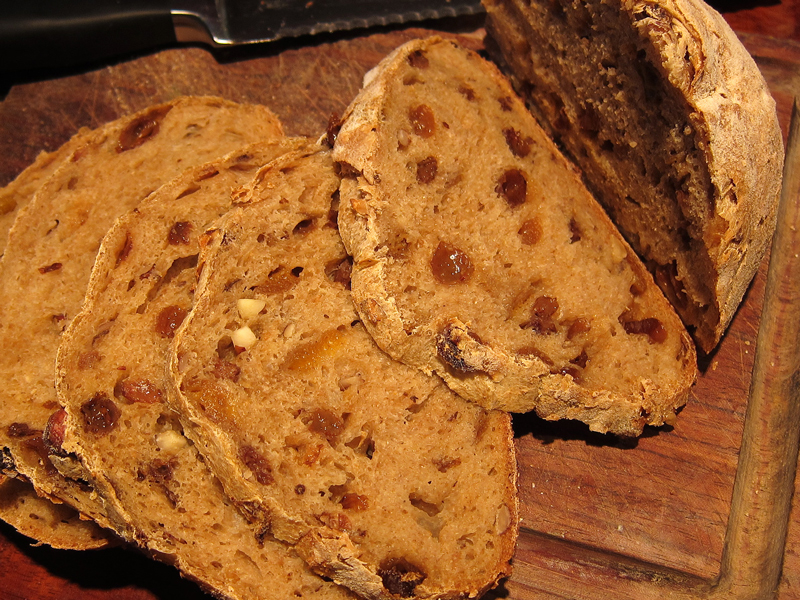Over the past couple of months I have been learning how to bake sourdough bread. I have produced a fair share of pale crusts, scorched bottoms, dense crumbs and one terrific doorstopper. I've spent hours on TFL looking for explanations and solutions (and finding them! Big thanks to all of you!). I think I'm slowly getting the hang of it. Last Sunday I tried my first sourdough with fruit and nuts and it all seemed to come together: it was delicious! As good a reason as any to start using the TFL blog :).

Formula:
- 170 gr starter (I have a 100% hydration starter, maintained on roughly 1/3 rye and 2/3 wheat),
- 230 gr water
- 510 gr flour (about 20% wholemeal)
- 10 gr salt
- 250 gr dry ingredients for soaker: 100 gr raisins, 50 gr dried apricots chopped to raisin size, 50 gr hazelnuts crushed with a hammer, 50 gr rolled oats
- zest from one medium orange, and some Madeira wine.
Method:
- Start with the soaker: cover the dry ingredients with water and a generous splash of Madeira wine in a small saucepan, heat up to "nice and warm", leave to cool for 6 hours, stirring now and then. Put in a sieve to drain off the liquid before starting on the dough.
- Mix flour, starter and water. Autolyse. Add salt and orange zest and knead gently (about 5 minutes). Rest a few minutes, add soaker and knead some more.
- Bulk ferment, do a stretch&fold at 50 and 100 minutes.
- Retard in fridge overnight.
- Take out of fridge, allow about two hours to get back to room temperature (my fridge is very cold), divide and preshape. Benchrest. Shape (if any raisins have worked their way out of the dough, remove them or push them into the bottom of the boule) and proof.
- Heat oven with stone to 220C (430F).
- Slash and bake covered for the first 13 minutes. Let oven temp drop to 200C (390F) and bake another half hour.
Schedule:
I use a spreadsheet I made to calculate quantities and to keep track of when I need to do what. You can see it here (I'd be happy to share the original spreadsheet). My house if fairly cool (room temp around 66F), hence the long proofing times.

Notes:
My basic bread formula is Flo's 1.2.3 formula, with just a bit less water, because I do all dough handling except the final shaping with wet hands. For final shaping I use flour.
I cover my loaves in the oven with a tinfoil hat shaped around an upturned banneton. Works like a charm.
250 grams of dry ingredients swells up to a much bigger and heavier load after soaking (smells nice, though). It was quite scary to tip that quantity onto the dough; hydration went up too, obviously. Still, I got a good windowpane after the second stretch & fold and the dough was still manageable (just).
Funny thing was that we couldn't find a trace of the oats in the finished loaf, but I think they did contribute to the taste.
The crumb was more dense than in my "daily" loaf (which is made using the same method, but without the soaker), there were no big holes. Still, it looked and felt lovely, pleasantly moist.
We had a loaf for lunch, even though it was still so warm that butter on a slice melted almost immediately. My lunch companions are very critical foodies, and they loved it (one of them is my brother, and believe me, he wouldn't say so just be polite :)).
It really was delicious - on its own, with butter or with strong dutch cheese!
- Jaydot's Blog
- Log in or register to post comments
I like the soaker you've come up with. I'll bet the loaves were delicious. One question, one comment. Question: why do you cover the loaves with the tin-foil banneton for the initial bake? I think you might get better color with no covering.
Comment: Given the quantity of soaker, I suspect if you upped the percentage of levain (say to 25% - 30% of total dough weight) you might get a more open crumb. All that fruit and nuts could use a little extra lift.
Nice bake.
Larry
Rolled oats are a great "secret ingredient". They do tend to vanish, especially when soaked, but they really add a nice extra dimension to the flavor. The combination of flavors you've come up with for this bread sounds absolutely delicious!
Marcus
Thank you, kind sirs!
@Larry: I use the foil to capture steam - the oven spring as well as the shape of my loaves have improved enormously since I started doing that. I'm still working on a better crust colour. The one time (up to now) I got it right, the loaf had a scorched bottom (and I had used the foil) :).
Your comment on the percentage of levain is probably spot on, I'll remember that for the next time!
@Marcus: Indeed, oats are good! I'm planning to include them more often, I'm curious what they will be like unsoaked.
and easy!
Adding zest from some orange is a good idea! They look so good!!
Akiko